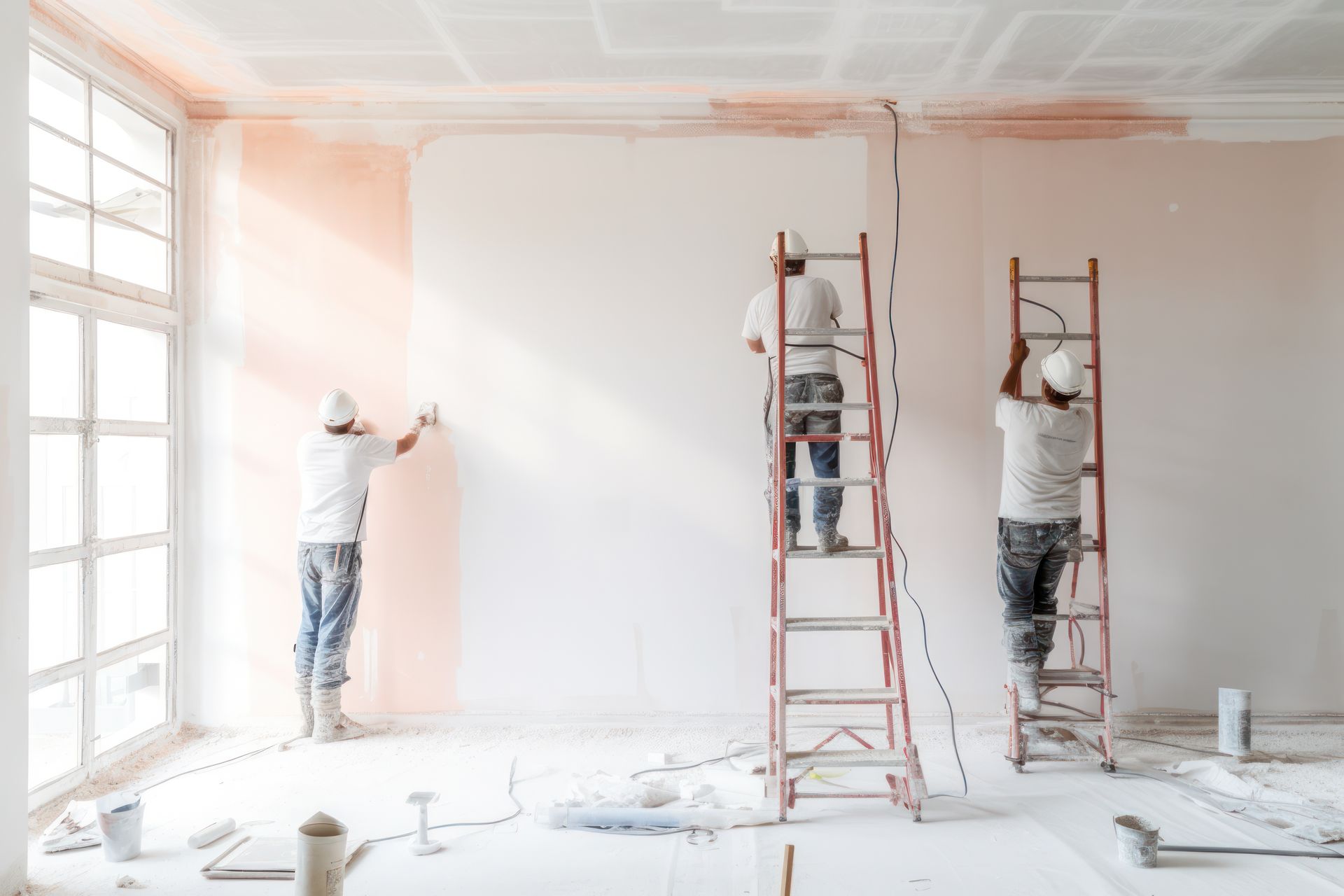Driving through established Plano, McKinney, or Frisco neighborhoods reveals North Texas's enduring love affair with brick—warm red tones, classic orange-tinged facades, and the substantial permanence that brick architecture represents. For generations, brick has defined Texas residential architecture, symbolizing quality construction, timeless appeal, and the solid, dependable character that homeowners seek. Yet an increasing number of Dallas-Fort Worth homeowners are making a decision that would have seemed radical just a decade ago: painting their brick exteriors. This transformation from traditional exposed brick to painted surfaces represents one of the most dramatic home updates possible, capable of completely reinventing a property's appearance while sparking passionate debates about preservation versus modernization, traditional aesthetics versus contemporary style, and whether painting brick constitutes improvement or sacrilege.
Understanding the implications of painting brick—a permanent decision that fundamentally changes your home's character and maintenance requirements—requires careful consideration of both aesthetic preferences and practical realities. The painted brick trend sweeping through Texas neighborhoods reflects broader design movements toward clean, modern exteriors and light, bright color palettes, but it also creates ongoing maintenance obligations and eliminates the low-maintenance appeal that made brick attractive originally. For Plano homeowners contemplating whether to paint their brick homes, the decision extends far beyond simple color preference to encompass questions about architectural appropriateness, neighborhood context, resale implications, and long-term maintenance commitment. The choice between maintaining traditional brick character or updating to modern painted aesthetics represents a crossroads where personal taste meets practical considerations and where the right answer depends entirely on your specific circumstances, goals, and willingness to accept the permanent nature of the transformation.
The painted brick phenomenon has gained such momentum that what once marked homes as boldly different now increasingly represents a mainstream choice, particularly in neighborhoods where multiple properties have already made the transition. However, the decision's permanence—returning painted brick to its original appearance proves extremely difficult and expensive—means homeowners must approach this update with clear understanding of what they're gaining and what they're permanently surrendering. For North Texas families considering this dramatic transformation, knowing the full implications of painting brick helps ensure decisions align with long-term goals rather than simply following current trends that may or may not stand the test of time.
The Case for Traditional Exposed Brick
Before exploring painted brick options, understanding what makes traditional exposed brick so enduringly popular in Texas helps frame the decision about whether painting represents genuine improvement or needless alteration of something already valuable and attractive.
Brick's inherent beauty stems from its natural color variation, texture, and the craftsmanship visible in quality masonry work. Each brick carries subtle differences in tone—some slightly darker, others lighter—creating the organic, lived-in character that manufactured uniformity can never replicate. The mortar joints add dimensional texture that paints flatten, and the slight irregularities in vintage brickwork tell stories of hand-laid craftsmanship that modern construction often lacks. For homes in established Plano and McKinney neighborhoods, this authentic character represents irreplaceable historical value that painting permanently obscures.
Maintenance advantages of unpainted brick rank among its most practical benefits. Quality brick requires virtually no maintenance beyond occasional cleaning, doesn't need repainting every decade, won't peel or fade, and stands up to Texas weather extremes without the deterioration that affects painted surfaces. Brick's permanence means you're done once it's installed—no ongoing paint refresh cycles, no worrying about color fading in intense Texas sun, and no budget allocation for exterior repainting every ten to fifteen years. For homeowners who view exterior maintenance as burden rather than opportunity, unpainted brick's set-it-and-forget-it appeal represents enormous value.
Architectural authenticity matters particularly for homes built during eras when exposed brick defined residential design. Mid-century ranch homes, traditional colonials, and classic Georgian designs were conceived with exposed brick as integral design elements, and painting these facades can undermine the architectural integrity that makes these homes distinctive. In North Texas neighborhoods featuring cohesive architectural styles, maintaining exposed brick honors the community's character while painted outliers can feel discordant.
Resale considerations favor unpainted brick in many market segments. While painted brick appeals strongly to buyers seeking modern aesthetics, other buyers specifically seek traditional character that exposed brick provides. Once painted, your home excludes buyers who prefer traditional brick, potentially limiting your eventual sale audience. Additionally, poorly executed painted brick—and there's plenty of it—significantly reduces home values, making the quality of any painting project absolutely critical to protecting your investment.
The Modern Appeal of Painted Brick
Despite traditional brick's advantages, painted brick's surging popularity reflects genuine aesthetic and practical benefits that resonate with contemporary design preferences and modern lifestyle priorities.
Transformative visual impact represents painted brick's primary appeal. Painting brick completely reinvents a home's appearance, creating dramatic before-and-after transformations that make properties look larger, brighter, and more current. Dark or orange-toned brick can make homes feel dated and visually heavy, while crisp white or soft gray painted brick creates fresh, light, contemporary appeal that photographs beautifully and stands out in neighborhoods of traditional brick. For homes with awkward brick colors—the orange-heavy tones popular in the 1970s or muddy browns that never age well—painting offers the only practical way to update appearance without completely re-siding the home.
Design flexibility through color selection lets homeowners create exactly the aesthetic they want rather than accepting whatever brick color their home happened to receive decades ago. While exposed brick limits you to its existing tones—which you may love or merely tolerate—painting opens infinite color possibilities. Crisp whites create modern farmhouse charm, soft grays deliver contemporary sophistication, warm creams suggest traditional elegance, and even bold accent colors become possible when you control the palette. This flexibility lets your home reflect your personal style rather than displaying someone else's 1975 color choice.
Cohesive exterior design becomes easier with painted brick, particularly for homes featuring multiple exterior materials. Many Texas homes combine brick with siding, stone, or other materials, creating visual complexity that can feel busy or disjointed. Painting the brick to coordinate with these other elements creates unified, intentional appearance rather than the patchwork look that mixed materials sometimes produce. Similarly, painting dated or damaged brick eliminates the visual distraction that worn, stained, or inconsistent original brick creates, presenting your home as polished and well-maintained.
Covering problem brick provides practical solutions for homes with staining, efflorescence, or color inconsistencies that cleaning can't resolve. While quality brick ages beautifully, problematic brick develops permanent discoloration, water staining, or damage that makes homes look neglected. Painting effectively covers these imperfections, creating fresh appearance without the enormous expense of brick replacement. For North Texas homes with brick damaged by improper repairs, mismatched additions, or environmental staining that resists cleaning, painting may represent the only economically sensible aesthetic solution.
Color Selection: What Works in Texas
If you decide to paint your brick, color selection determines whether the result looks intentionally sophisticated or like you followed a trend without considering your home's specific character and neighborhood context.
White painted brick dominates current trends, creating the bright, clean, modern aesthetic that drives much of painted brick's popularity. However, white isn't singular—it ranges from warm, creamy whites suggesting traditional elegance to crisp, cool whites delivering contemporary edge. For Texas homes, warm whites typically work better than stark whites because they prevent the harsh, glaring appearance that bright white can create under intense sun. Consider your home's architectural style when selecting white tones—traditional homes benefit from warmer whites, while contemporary builds can handle cooler, crisper whites. Additionally, remember that white shows dirt, pollen, and environmental staining more readily than darker colors, requiring more frequent cleaning in Texas conditions.
Gray painted brick offers sophisticated alternatives to white while maintaining the light, modern appeal that makes painted brick attractive. Soft, warm grays create contemporary elegance without white's stark contrast, aging more gracefully and hiding environmental wear better than pure white. Gray coordinates beautifully with most roof colors, stone accents, and landscaping, making it versatile across various home styles. However, avoid cool blue-grays that can feel cold or industrial on residential exteriors, instead choosing grays with subtle warm undertones that prevent sterile appearance while maintaining modern sophistication.
Warm neutrals including soft beiges, taupes, and greige (gray-beige hybrids) provide middle ground between traditional brick colors and modern painted aesthetics. These colors update dated brick without the dramatic transformation that white creates, potentially appealing to homeowners who want refreshed appearance without completely abandoning traditional character. Warm neutrals also coordinate effortlessly with Texas landscaping, stone elements common in North Texas homes, and the warm climate aesthetics that define regional style. These colors represent safer choices for homeowners uncertain about committing to the boldness of white painted brick.
Unexpected colors including soft sage greens, muted blues, or even black create distinctive statements when executed carefully on appropriate architecture. While risky, these bolder choices can distinguish homes in competitive markets and create memorable curb appeal that generic white doesn't achieve. However, unconventional colors require confident execution, appropriate architectural context, and acceptance that they'll polarize opinions—some people will love them, others will hate them, and this division affects resale appeal. Reserve bold colors for homes with architectural character that supports distinctive treatment rather than applying them to standard suburban ranches where they may appear incongruous.
Traditional Color Palettes That Honor Brick Heritage
For homeowners wanting to paint brick while maintaining connection to traditional aesthetics rather than pursuing contemporary trends, specific color approaches honor brick's heritage while providing refresh and protection.
Limewash applications represent historically authentic alternatives to standard paint, creating soft, mottled appearance that allows brick texture and variation to show through rather than covering it completely. Limewash has been used on brick and stone for centuries, offering genuine period authenticity for historic homes while providing the lighter, refreshed appearance that appeals to modern sensibilities. The technique creates organic, aged appearance that feels intentional rather than trying to look brand new, and the breathable nature of limewash allows moisture vapor transmission that prevents the trapped-moisture problems standard paint can create. For Plano homes in historic districts or homeowners who appreciate traditional aesthetics, limewash offers compromise between exposed brick and fully painted surfaces.
German schmear or mortar wash techniques involve applying thinned mortar over brick in irregular patterns, creating Old World European appearance that's gained popularity in Texas design circles. This technique leaves significant brick color visible while introducing white or cream tones that lighten overall appearance without completely covering the brick. German schmear creates rustic, textured look that feels authentic and substantial rather than trendy, making it particularly appropriate for homes with traditional or Mediterranean architectural influences. The irregular application means each home develops unique character, and the technique requires less ongoing maintenance than full paint coverage since it doesn't create uniform surface that shows every imperfection.
Historic color palettes using period-appropriate painted brick colors honor traditional aesthetics while providing the coverage and color control painting offers. Research your home's architectural era to identify authentic color schemes that would have been used when your home style was built. Federal-era homes used soft whites and creams, Victorian homes embraced multiple colors highlighting architectural details, and early twentieth-century homes favored warm whites and buff tones. Using historically appropriate colors makes painted brick feel intentional and architecturally coherent rather than simply following current trends without consideration for your home's heritage.
The Process and Commitment of Painting Brick
Understanding what's involved in painting brick—the preparation, application, and ongoing maintenance—helps homeowners recognize whether they're truly ready for this commitment or whether the romance of painted brick outweighs their willingness to maintain it properly.
Surface preparation determines painted brick success more than the paint itself. Brick must be thoroughly cleaned, all efflorescence removed, mortar joints inspected and repaired as needed, and the entire surface allowed to dry completely before any paint application. Painting dirty or damp brick guarantees premature failure. Additionally, brick's porous nature means it absorbs paint heavily during initial application, requiring specialized primers designed specifically for masonry to create appropriate base layers for topcoats. Proper preparation typically takes longer than the actual painting, and shortcuts during this phase create problems that undermine even the highest quality paint.
Paint product selection requires specialized masonry paints formulated to breathe, allowing moisture vapor to escape while preventing water infiltration. Standard house paints trap moisture, causing adhesion failures, efflorescence, and potential structural damage to brick and underlying walls. Quality masonry paints cost significantly more than standard exterior paints, but this isn't an area where economizing makes sense. Using inappropriate products to save money creates failures requiring complete removal and reapplication, ultimately costing far more than investing in proper materials initially.
Application technique matters enormously for painted brick, with proper methods ensuring paint penetrates mortar joints, covers textured surfaces uniformly, and creates the smooth, professional finish that makes painted brick attractive. Spraying typically provides best coverage for brick's irregular surfaces, though it requires extensive masking and protection to prevent overspray. Back-rolling after spraying pushes paint into crevices and creates uniform appearance that spraying alone might miss. DIY painted brick projects often fail because homeowners underestimate the technique challenges brick presents, creating uneven coverage, visible brush marks, or inadequate penetration into mortar joints that compromises both appearance and protection.
Ongoing maintenance requirements for painted brick include repainting every ten to fifteen years as the coating degrades, periodic cleaning to remove environmental staining, and prompt attention to any areas where paint fails to prevent moisture infiltration. This represents permanent commitment—once painted, brick must be maintained as painted surface indefinitely. The occasional power-washing that maintained unpainted brick becomes regular repainting cycles that incur ongoing costs and periodic disruption. For homeowners attracted to painted brick's appearance but unprepared for this maintenance obligation, the long-term reality may prove less appealing than the initial transformation suggested.
Making the Right Decision for Your Home
Deciding whether to paint brick requires honest assessment of your goals, your home's specific circumstances, and your willingness to commit to the permanent nature of this transformation and its ongoing maintenance requirements.
Consider your home's architectural style and neighborhood context before deciding. Painting brick on a mid-century modern home might enhance its clean lines, while painting a traditional Georgian colonial could undermine its period authenticity. Survey your neighborhood—if you'll be the first painted brick home, consider whether you want that distinction or whether waiting until the trend reaches your area makes more sense. Being too far ahead of neighborhood evolution can make your home feel out of place rather than cutting-edge.
Evaluate your true motivation for wanting painted brick. Are you responding to genuine aesthetic preferences aligned with your taste, or are you following a trend because it's currently popular? Trends fade, but painted brick remains permanent. Ensure your reasons for this dramatic change will remain valid five, ten, or fifteen years from now when the trend cycle has moved on and you're still living with the decision.
Assess your maintenance willingness realistically. If you love the idea of painted brick but resent exterior maintenance, this mismatch will create regret once the reality of periodic repainting becomes clear. Conversely, if you enjoy refreshing your home's appearance and view maintenance as opportunity rather than burden, painted brick's requirements may align perfectly with your preferences.
Consider professional consultation before making final decisions. Experienced painting contractors like Hutch'N'Son Painting can assess your specific brick condition, discuss color options appropriate for your home and neighborhood, explain the process and maintenance requirements, and show examples of their completed projects so you understand realistic outcomes rather than Pinterest ideals. Professional guidance helps you make informed decisions based on your specific circumstances rather than generic advice that may not apply to your situation.
Bringing Your Vision to Life
Whether you decide to paint your Texas brick home to achieve modern aesthetic transformation or choose to honor traditional exposed brick character, the decision represents significant investment in your home's appearance and long-term maintenance trajectory. For homeowners who do choose to paint, the difference between results you'll love for decades and outcomes you'll regret within years comes down to proper planning, quality execution, and realistic expectations about the permanent nature of this change and the ongoing commitment it requires.
The painted brick trend will evolve, possibly giving way to new preferences or perhaps becoming so established that it represents permanent shift in residential design thinking. What remains constant is that painting brick constitutes permanent decision requiring careful thought about whether transforming your home's appearance justifies accepting the maintenance obligations and commitment that painted brick demands. For some Plano, McKinney, and Frisco homeowners, painted brick delivers exactly the fresh, modern aesthetic they seek. For others, traditional exposed brick's character and maintenance-free appeal remains preferable. Neither choice is objectively superior—the right answer depends entirely on your specific goals, preferences, and circumstances.
Ready to explore whether painted brick suits your North Texas home, or looking for expert execution of your brick painting project? Hutch'N'Son Painting has served the Plano, McKinney, and Frisco areas since 1985, bringing decades of experience to both traditional and modern painting projects including specialized brick painting applications. Our comprehensive approach includes honest assessment of whether painted brick suits your specific home, guidance on color selection that honors your architecture while achieving your aesthetic goals, proper surface preparation using appropriate masonry primers and specialized techniques, and quality application that delivers the smooth, professional finish painted brick requires to look its best. We understand the permanent nature of brick painting decisions and provide the candid consultation you need to make informed choices aligned with your long-term goals. Contact us today to schedule your consultation and discover whether painted brick or traditional exposed brick represents the best choice for your Texas home's unique character and your family's lifestyle.






